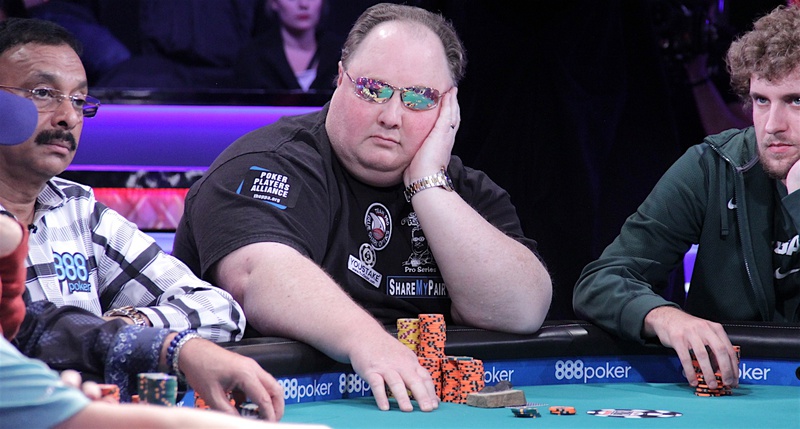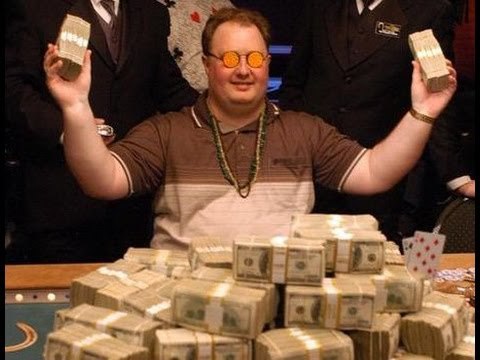






Greg Raymer Not Impressed By Being Last Former Champ Left In 2016 WSOP Main EventPoker Pro Makes First Cash In Main Event Since 25th Place In 2005 |
|
|
 The last former champion alive in the 2016 WSOP main event was 2004 winner Greg Raymer, who sat with an average stack with fewer than 160 left on Saturday.
The last former champion alive in the 2016 WSOP main event was 2004 winner Greg Raymer, who sat with an average stack with fewer than 160 left on Saturday.
For Raymer, who might have made the final table again in 2005 had it not been for a brutal hand against Aaron Kanter, the title of last champ standing means nothing. Johnny Chan, the 1987 and 1988 winner, hit the rail in 180th place on day 5, which was good for a $42,285 payday.
“I was reading [a media report] this morning and it talked about how he and I were fighting to be the last champ standing,” Raymer said. "No, we were fighting to be the next champ standing. That’s the reality. I don’t get paid extra for being the last champ left. I’m trying to win the $8 million.”
Raymer won $5 million in 2004, and his 25th-place finish in 2005, which was the last time he cashed in the main event prior to this year, was good for $304,000.
“Fossil Man” is already thinking about how great it would be for his second bracelet to be in the tournament that put him on the poker map right when the poker boom was beginning. However, the 52-year-old North Carolinian knows very well that you can’t get too far ahead of yourself in the main event, or you might blow up.
“There’s still so far to go,” Raymer said. “In a lot of the tournaments I’ve won over the past several years, the starting fields weren’t much bigger than [160 players]. So, even though this is great and all, I still have like 331 million chips to go.”
 When Raymer won the main event the field size was a record 2,576, more than triple the number of players the year before when Chris Moneymaker altered the course of poker history. The main event field size reached a peak of 8,773 in 2006, but it has remained steady over the past decade. This year’s field size of 6,737 was the largest in five years.
When Raymer won the main event the field size was a record 2,576, more than triple the number of players the year before when Chris Moneymaker altered the course of poker history. The main event field size reached a peak of 8,773 in 2006, but it has remained steady over the past decade. This year’s field size of 6,737 was the largest in five years.
Raymer said that the experience of being deep before allows him to play his A-game at times when other players might be feeling the pressure of the lights and cameras, as well as the massive money jumps. He also knows you can dominate by almost going back-to-back and then not cash in the event in over a decade.
“I think my edge is that, even though there are great players still in the field, many of them haven’t been in this situation before,” Raymer said. “It brings up more emotions, and it’s the emotions that cause you to exhibit tells so that you are easier to read. Emotion causes you to make mistakes that you wouldn’t normally make.”
With so many players and a significant portion of the field being amateurs, the main event is often described as a minefield, but, according to Raymer, that characterization applies to any tournament with a big field these days. The difference is that the main event has so much money on the line and the psychological toll that comes from a bad beat or a fatal mistake is a lot to deal with.
“Because it’s the main event you feel it a lot more when one of those mines blows up in your face,” Raymer said of navigating thru a seven-day poker tournament.
Because it has been so long since his last deep run, Raymer said the memory of falling short in 2005 isn’t on his mind. The time has healed that disappointment, and now it’s about making the most of this opportunity. You can never count on a deep run happening again.
“I don’t think any one tournament can redeem anything,” Raymer said. “You just play your best. It’s really hard to judge someone’s skill level based on tournament results, to be honest. If someone has massively good results then they have to at least be really good, but it doesn’t mean they are the best. Someone can have mediocre results for a period of time and that doesn’t mean they aren’t a good player either.”
His remarkable runs in 2004 and 2005 were the product of great play, but Raymer did enjoy big stacks throughout the tournament in both years, and he used his chips and table image to find some spots where an opponent would disintegrate and basically gift him all their chips. He seemed to have an uncanny ability to spark a blowup from an opponent. This year, thanks to not having a top stack, he’s had to adjust his play. But it’s also a different era of poker.
“I certainly still have [people playing back at me], but I’m not sure I get it a lot more than other people now,” Raymer said. “It happened more in the past because in 2004 and 2005 I was one of the big stacks. I was appropriately playing a lot of hands. Also, the skill level of opponents back then was lower, so it was more correct to play more hands. Because people play better now, you probably shouldn’t be playing a lot of extra hands even if you have a big stack. The fact that I was in those spots for a couple of years meant I was in position to catch blowups.”
According to Raymer, tanking in the main event, especially in its later stages, is better and worse than it was over a decade ago. That’s another way the game has evolved.
“For the big decisions, it was worse back then,” Raymer said. “You were much more likely to have someone thinking about one decision for 10 or 15 minutes if no one called a clock. Today, even if it’s for all your chips this deep in the main event, someone is going to call the clock by the time five minutes goes by. They aren’t going to give you 10 or 15. But when it comes to just the routine preflop decisions, it’s worse today. That’s really the biggest concern I have, if you have someone taking 20 to 30 seconds for every preflop decision.”
